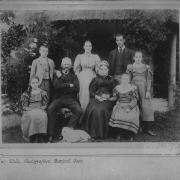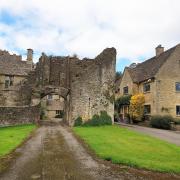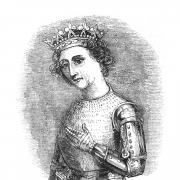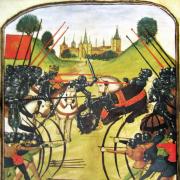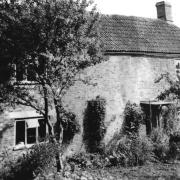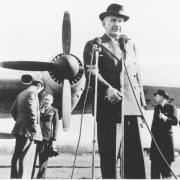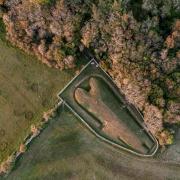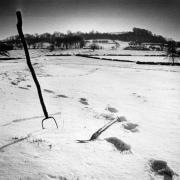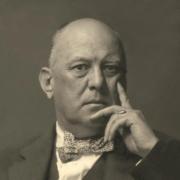From Windrush Valley to Stinking Bishop, the Cotswolds has some of the finest offerings for the cheeseboard, says Hermione Taylor in the fifth part of her fascinating series on things that made the Cotswold economy
You can make a cracking cheeseboard with Cotswold cheeses. According to tradition, the key is variety: you need a hard cheese, a blue cheese, a soft cheese and a goats’ cheese. And local cheeses can certainly deliver. Double Gloucester, a Cotswold Blue Brie, a wheel of Rollright, and a Cerney Pyramid? Or maybe a slab of Single Gloucester, an Oxford Blue, a Stinking Bishop and a Windrush Valley Goats’ Cheese? I’ll have them all!

For somewhere with rolling pastures perfect for grazing, it is no surprise that the Cotswolds was once home to millions of sheep. And these sheep produced plenty of milk, meaning cheese production has a rich history in the area. Cheese making came about as a means of preserving all of this milk, and the cool, thick stone walls of Cotswold barns were perfect for storing and ageing wheels of cheese.
Before the industrial revolution, cheese was made at local farmhouses, and there were hundreds of regional varieties. Chedworth cheese, still made by King Stone Dairy today, is a classic example. This style of cheese was known as the ‘haymakers’ cheese’, and was made with milk from the spring flush – the period where cows return back to pasture after a winter of dried food. The cheese would then be ready in time to feed labourers as they worked the fields during harvest time. It is still available from the Cotswold Cheese Company today, and has a ‘zesty and yoghurty’ flavour. If you want to try some in the name of historical research, I can vouch that it is delicious.

But the advent of the railway dealt the first blow to local cheesemaking. Once fresh milk could be transported quickly to nearby towns and cities, the need to preserve it as cheese began to fade away. At the same time, factories in cities began to use any leftover milk to make cheese on an industrial scale. This period saw cheese production heavily standardised – acidities were measured and specific bacteria were introduced to ensure consistency – and regional specialities began to fade away
In 1933, something called the Milk Marketing Board was set up. This guaranteed farmers a price for their milk, and even arranged for it to be collected from farms, and so selling fresh milk, rather than cheese, instantly became much more attractive. The Milk Marketing Board often found itself with surplus milk, and took to producing cheese, meaning farmhouse production faded yet further. In 1935, TS Eliot even wrote a letter to The Times suggesting that British cheeses, from Stilton to ‘noble all Cheshire’, were on the brink of extinction. And when the Second World War hit, cheese was not only rationed (adults were allocated 2oz a week – around three Babybels) but subject to Milk Marketing Board standardised recipes. By the time rationing came to an end in 1954, hundreds of varieties of British cheese had disappeared.

But luckily, several of our iconic Cotswold cheeses survived. The famous Double Gloucester is thought to be at least 200 years old, and survived extinction in the 1950s when firms such as Charles Martell & Son started production in the 1970s. He also revived the Single Gloucester cheese, which was even awarded coveted Protected Designation of Origin in 1997. For a cheese to be a true Single Gloucester, it needs to be made in Gloucestershire, on farms with a herd of Old Gloucester Cows – meaning it ranks alongside Champagne and Cornish clotted cream.
Hearteningly, even greater cheese variety is returning to the area. In 1994, Charles Martell revived another traditional cheese, the famous ‘Stinking Bishop’ – a soft cheese inspired by the cheeses made by the monks who once lived in the area. Don’t let the name put you off – it doesn’t refer to the smell of the cheese, but the cheese’s namesake, a 19th-century local farmer called Frederick Bishop. The mid-1990s also saw the creation of Oxford Blue cheese, a creamy soft blue cheese developed by Baron Pouget to rival Continental Cambazola. And last year’s lockdown saw cheese production get even more local, with farm shops and artisan producers getting a boost as people opted to shop close to home.

And with a range of celebrity producers, could the Cotswolds soon be back on the cheesemaking map? Blur’s Alex James swapped band life for the country life, and now produces the creamy Blue Monday Cheese – and to add to its celebrity credentials, it is available at Jeremy Clarkson’s Diddly Squat Farm Shop. Then there is Daylesford Farm. Beloved of celebrities, from the Beckhams to Gwyneth Paltrow, it produces an award-winning range of organic cheeses. These include a Single and Double Gloucester, and the Adlestrop, named after the village near the Cotswold farm.

But surely the most famous Cotswold cheese of all is the one set to roll down a hill on Monday, May 30. The Cooper’s Hill Cheese Roll has been going since the 1800s, and was even the feature of a Netflix documentary on ‘bizarre competitions’ in 2020. The now world-famous event involves competitors dashing down an extremely steep hill in pursuit of an 8lb wheel of Double Gloucester cheese. The origins of the event are hazy, with some saying it was a way of claiming grazing rights on the land around Cooper’s Hill, and others arguing it was a fertility ritual.
Today, it is more like an extreme sport: competitors literally tumble head over heels and, in 1997, a record 33 competitors were injured. The ‘official’ Cheese Roll was actually cancelled in 2009 after more than 15,000 people turned up as spectators to watch the competition, meaning the race we see today is a rebel event. The race remains so popular that it was cancelled in 2020 and 2021 as pandemic restrictions prevented crowds forming. But tradition was still maintained: the Master of Cheese, Jam Wakeman, awoke at dawn to roll a cheese alone down Cooper’s Hill.

And after risking life and limb, what does the winner of the Cheese Roll take home? A wheel of cheese, of course! The most successful cheese chaser ever is Chris Anderson, who has won the men’s race an incredible 22 times. But he hasn’t tucked into his own bodyweight in cheese, revealing in an interview in 2018 that he auctioned his hard-earned winnings off in support of a local charity, Joseph’s Goal. And despite hurtling down a hill in pursuit of a wheel of Double Gloucester, he only really likes cheddar cheese.




